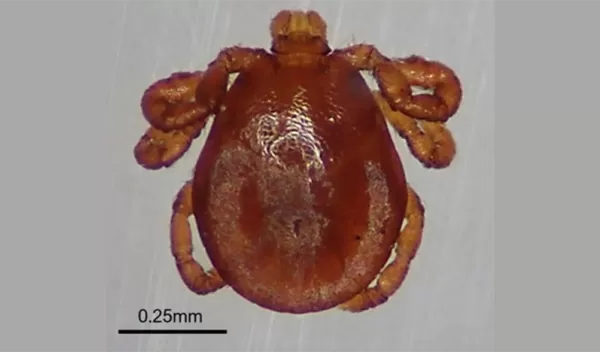
Researchers warn of tick-borne disease babesiosis
'Tis the season for hiking now that spring has arrived and temperatures are on the upswing. But with hikes come insect bites and on the increase in North America is babesiosis, a malaria-like disease spread especially between May and October by a tick.
Recent research suggests an increase in the incidence of diseases transmitted by ticks around the world, not just the United States and Canada, due likely to climate change and other environmental factors. Among the tick-borne pathogens, Babesia parasites, which infect and destroy red blood cells, are considered a serious threat to humans and animals. All cases of human babesiosis reported in the U.S. have been linked to either B.microti, B. duncani or a species similar to B. divergens.
Now, a U.S. National Science Foundation-supported research team led by scientists at the University of California, Riverside, and Yale University reports the first high-quality nuclear genome sequence and assembly of the pathogen B. duncani. The team also determined that the 3D genome structure of this pathogen resembles Plasmodium falciparum, the malaria-causing parasite.
"Our data analysis revealed that the parasite has evolved new classes of multigene families, allowing the parasite to avoid the host immune response," said Karine Le Roch of UC Riverside, who co-led the study with Choukri Ben Mamoun of Yale University.
According to Le Roch, the study, published in Nature Microbiology, not only identifies the molecular mechanism most likely leading to the parasite's pathogenicity and virulence, but also provides leads for the development of more effective therapies.
"By mining the genome and developing in vitro drug efficacy studies, we identified excellent inhibitors of the development of this parasite — a pipeline of small molecules, such as pyrimethamine, that could be developed as effective therapies for treating and better managing human babesiosis," Le Roch said.
"Far more scientific and medical attention has been paid to B. microti. The genome structure of B. duncani, a neglected species until now, will provide scientists with important insights into the biology, evolution and drug susceptibility of the pathogen."
Human babesiosis caused by B. duncani is an emerging infectious disease in the U.S. and is often undetected because healthy individuals do not usually show symptoms. It has, however, been associated with high parasite burden, severe pathology and death in multiple cases. Despite the highly virulent properties of B. duncani, little was known about its biology, evolution and mechanism of virulence, and recommended treatments for human babesiosis against B. duncani are largely ineffective.
A strong immune system is required to fight the pathogen. A compromised immune system could lead to flu-like illness. The tick that spreads babesiosis is mostly found in wooded or grassy areas and is the same tick that transmits bacteria responsible for Lyme disease. As a result, around 20% of patients with babesiosis are co-infected with Lyme disease.
In older and immunocompromised people, if B. duncani is left unattended, babesiosis could worsen and lead to death. Once the pathogen enters the body and red blood cells start to get destroyed, fever, headache and nausea can follow. People who get bitten by the ticks often don't feel the bite, which complicates diagnosis. Skin manifestations of babesiosis are rare, the scientists said and difficult to separate from Lyme disease. They urge people to be mindful of ticks when they go hiking.
"Check yourself for tick bites," Le Roch said. "When you see your physician don't forget to let them know you go hiking. Most physicians are aware of Lyme disease but not of babesiosis."
Added Sylvia Spengler, a program director in NSF's Division of Information and Intelligent Systems, “This study is a great interaction of computer science, biology and pharmacology to characterize B. duncani, a species linked with potentially severe clinical outcomes in humans."
